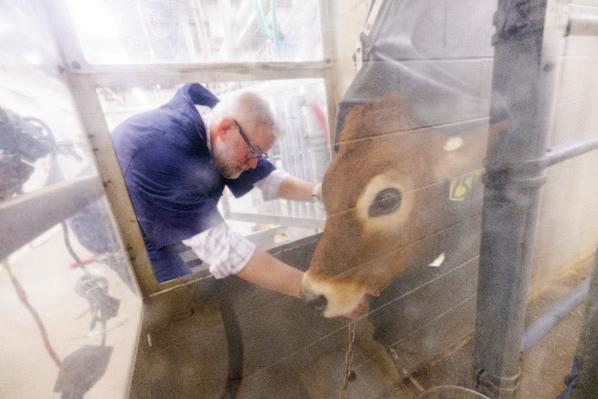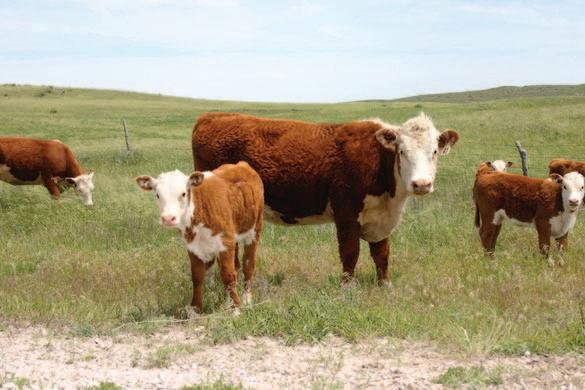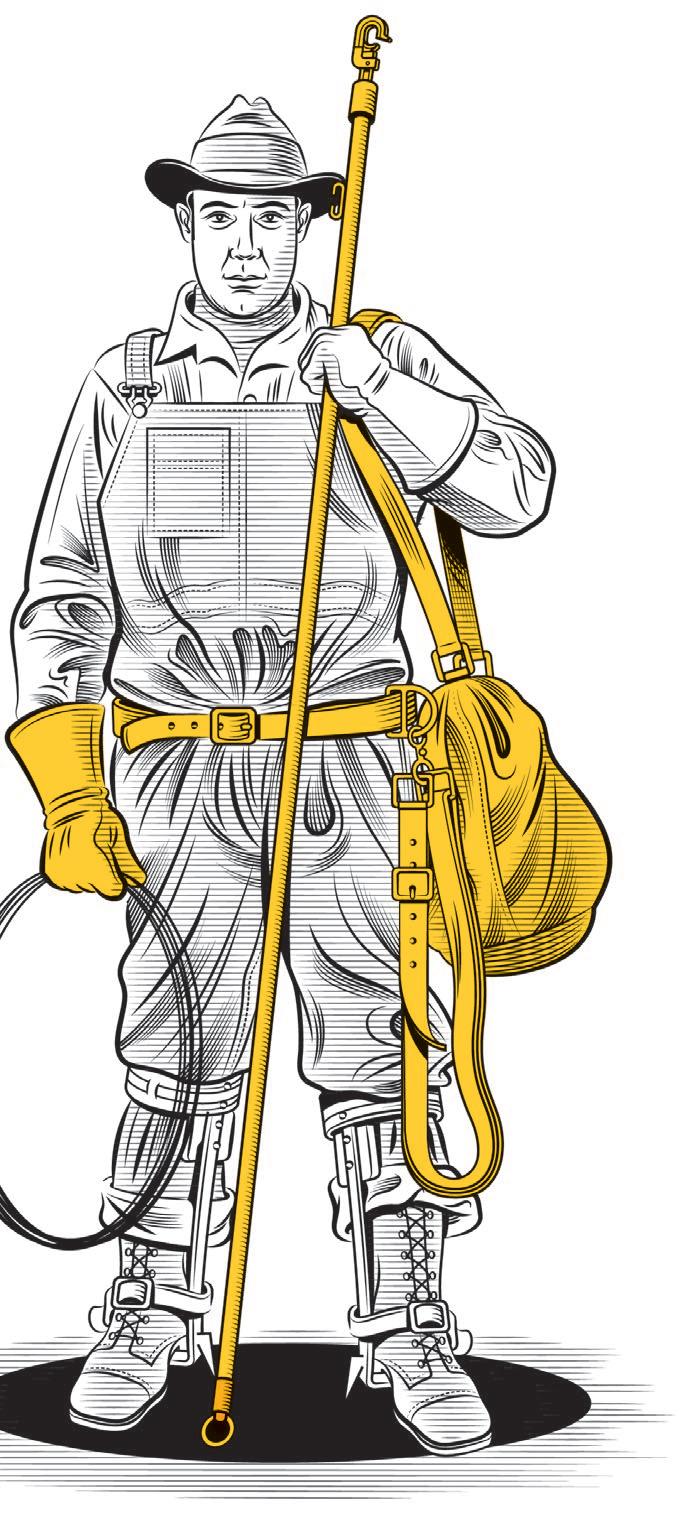














From the French Quarter to the hometown of Mark Twain, experience the best of this legendary river. On an 8 to 23-day journey, explore Civil War history and travel to the epicenter of American music as you cruise in perfect comfort aboard our brand new American Riverboat™.
Small Ship Cruising Done Perfectly ®
























Telling
Volume 78
Number 4
April 2024

Staff
General Manager
Rick Nelson
Editor
Wayne Price Editorial Assistant
Tina Schweitzer
President
Greg Strehle, Cuming County Public Power District
Vice President/Secretary
Vance McCoy Midwest Electric Cooperative Corporation
Treasurer
Dan Scheer
Howard Greeley Rural Public Power District
Published monthly by the Nebraska Rural Electric Association, 1244 K Street, Box 82048, Lincoln, Nebraska 68501, (402) 475-4988.
Advertising in the Nebraska Magazine does not imply endorsement for products by the Nebraska Rural Electric Association. Correspondence should be sent to Wayne Price, Editor, Nebraska Magazine, Box 82048, Lincoln, NE 68501.
The Nebraska Magazine is printed by the Aradius Group, 4700 F Street, Omaha, NE 68117. Form 3579 should be sent to Nebraska Magazine, Box 82048, Lincoln, NE 68501.
Periodicals postage paid at Lincoln, Neb.
POSTMASTER: send address changes to Nebraska Magazine, 1244 K Street, Box 82048, Lincoln, NE 68501.
Publication numbers are USPS 071-630 and ISSN 01934937.
Subscriber Services: Cost of subscription for consumers of participating member-systems is $2.14 per year (17.8 cents per month), plus periodicals postage paid from equity accruing to the consumer. For nonmembers, a subscription is $10 per year or $20 for three years, plus local and state tax. Single copy, $2.50.

Each year member-systems of the Nebraska Rural Electric Association select high school students to attend the NREA Youth Energy Leadership Camp. The 2024 Youth Energy Leadership Camp will be held July 22-26 at Camp Comeca, near Cozad, Neb.

A Husker research team has received $5 million from the U.S. Department of Agriculture to research more sustainable dairy and beef production. Writer Eric Buck explains how the research results will be used to develop new tools and practices for producers to continue producing food while reducing methane production from the animals that they care for.
Campers learn about Nebraska’s public power industry at the NREA Youth Energy Leadership Camp in July. Photograph by Wayne Price

Nebraska is quite prone to severe weather. Thunderstorms, lightning, high winds, tornadoes, hail, and flooding can all bring the wrath of Mother Nature to the doorstep in short order. Get ready now—before severe weather strikes.
Take the time to make plans with your family to be ready for any foul weather that might come your way. Making plans now just might save lives when floodwaters are rising or a tornado is bearing down on your home.
Assemble necessary supplies for a potential outage. Your emergency preparedness kit should include items such as water, food, flashlight, batteries, blankets, and a first aid kit.
The National Weather Service also recommends that you:
• Know the county you are located in and nearby towns and cities. Warnings are issued by county and reference major cities.
• Know the difference between a severe thunderstorm watch and warning. A watch means there is the possibility of storms in your area. A warning means a storm has been reported or is imminent and you should take cover.
• Check the forecast and the hazardous weather outlook.
• Watch for signs of an approaching storm.
• Turn on a weather radio or an AM/FM radio for information if a storm is approaching.
• Stay inside if you know a storm is headed your way.
• Make sure your cellphone is charged before the storm arrives.
Visit our website at nebraskamagazine.org

The best policy is to plan ahead so you do not get caught outside in a storm. Lightning can strike up to 10 miles from the area in which it is raining, even if you do not see clouds. This means that if you can hear thunder, you are within striking distance.
If you are inside, stay inside. Stay away from windows and go to the lowest level of your home. Unplug unnecessary appliances and don’t use corded phones. Cordless and cellphones are safe.
If you do get caught outdoors during a thunderstorm and are unable to take shelter in a building, try to take shelter in an enclosed vehicle with a hard-top roof—not an open-frame vehicle like a convertible or golf cart. Do not seek shelter under or stand near trees, canopies, small picnic or rain shelters, fences, or poles. Avoid water, high ground, and open spaces.
Take the time to prepare now, and pay attention to weather alerts to keep you family safe.

Mark Johnson
Mark Johnson is the General Manager of Elkhorn Rural Public Power District, headquartered in Battle Creek, Nebraska
As the General Manager at Elkhorn Rural Public Power District, I have the privilege of working with some of the most dedicated and hardworking individuals in the state. The employees at our public power districts and electric cooperatives, across the state, are what makes public power successful. Our crews are the backbone of our organizations, ensuring that our communities have access to reliable electricity day in and day out. On April 8th, we celebrate Lineworkers Appreciation Day. It is important to recognize the contributions that these individuals make to powering our lives.
Having worked in the industry for years out of state, I can attest to the unique challenges that lineworkers face in Nebraska. Our service territories cover vast stretches of land, often with limited access to infrastructure. We deal with many forms of inclement weather and, sometimes, unpredictable conditions. These variables are on top of the existing element of danger that comes with working around high-voltage electricity. This means that our line technicians must be resourceful and innovative, finding creative solutions to safely keep the power flowing to our customers.
Despite these challenges, our lineworkers are always up to the task. They are highly skilled professionals who undergo rigorous training to ensure that they can safely and effectively perform their jobs. They are also deeply committed to their communities, often going above and beyond to lend a helping hand to those in need. At this time, we can recognize the sacrifices that they make as well as their families. When an outage is called in and our trucks roll out, our employees leave their families to ensure power is restored to our customers’ homes and businesses.
This work ethic is always highlighted when a storm rolls through a system. Whether it’s responding to a call at their local utility or providing mutual aid to another district or cooperative in need. Rain or shine, day or night, our employees never shy away from answering the call.
Of course, the men and women in this field aren’t drawn to it for public recognition. Many of them are interested in the camaraderie and teamwork that comes with the job. Most like being outdoors. Some are following in a parent or relative’s footsteps by becoming a second or third-generation lineworker. Ultimately, they pursue their career because of the opportunity to make a meaningful impact. They find fulfillment in knowing that their work directly contributes to the well-being of their neighbors and fellow community members.
Lineworkers Appreciation Day is an opportunity to show our gratitude for the hard work and dedication of these individuals. I, for one, am proud to work alongside such a dedicated team of lineworkers and I am grateful for everything that they do. On April 8th, let us take a moment to thank these unsung heroes for their service and commitment to our communities.




Each year member-systems of the Nebraska Rural Electric Association select high school students to attend the NREA Youth Energy Leadership Camp. The 2024 Youth Energy Leadership Camp will be held July 22-26 at Camp Comeca, near Cozad, Neb.
The popular week-long camp was created to give young people a better understanding of public power, electricity, power generation, and the rural electric industry. The goal is to offer a program that challenges students educationally, socially, and recreationally.
The NREA Youth Energy Leadership Camp provides a “hands-on” approach to the public power industry and member-owned businesses.
The students will join other high school students from Nebraska and Wyoming, along with adult counselors and junior counselors.
A highlight of the camp involves a tour of the Kingsley Hydro Station at Lake McConaughy and Gerald Gentleman Station, a coal-fired power plant at Sutherland, Neb.
High school students who attend the energy camp may compete for a chance to participate in the National Rural Electric Cooperative Association’s Youth Tour in Washington, D.C. with expenses paid by the NREA. Three students are chosen as part of the Ambassador competition held during camp.

The adult counselors are employees of rural electric systems who donate their time and talents to the camp. The junior counselors are campers from the previous year who are selected by their peers to return in a leadership role.
On the first day of camp, a board of directors is elected to oversee the operation of the newly formed electric power district. The board then interviews and chooses a general manager to oversee the committee activities and act as a liaison between the counselors and campers.
Every participant has a role in the workings of the camp. Students can participate in the Ambassador competition or actively seek a position on the Board of Directors. Each student must also volunteer to serve on at least one of the committees responsible for various camp activities.
The competition involves submitting an application at camp, presenting a selfintroduction speech, and delivering a five-minute speech on an assigned topic. Each camper votes for three candidates following the speech with the top male, top female and the person with the next highest vote total becoming next year’s ambassadors. The top six finalists are invited to return to next year’s Youth Energy Leadership Camp as junior counselors.
Recreational activities include basketball, volleyball, and swimming. Students will also have the opportunity to use a rock climbing wall and adventure course.
Camp costs and transportation are provided by each sponsoring rural electric system. Students that are currently freshmen, sophomores, and juniors whose families are customers of NREA member-systems may apply.
For more information about attending Youth Energy Leadership Camp, send the RSVP form to your rural electric utility.
Katie Schultis, a fourth-year University of Nebraska Medical Center student, is from Diller, a town of 250 in southeast Nebraska. Like many rural areas, Diller faces a critical shortage of health professionals.
“Growing up, I was well aware of the limited access many communities in our state have to the care they need and deserve,” Schultis says. “That’s why, when my education is complete, I’ll be going home.” Schultis is not alone. Nearly 60% of the physicians, dentists, pharmacists and physician assistants practicing in Greater Nebraska – outside of the Omaha and Lincoln metro areas – were educated at UNMC and received training at Nebraska Medicine, the university’s primary clinical partner.
But there is still work to be done. UNMC and Nebraska Medicine, a leading American academic health system, are committed to addressing the growing health care needs of all Nebraskans - UNMC, as the state’s only public sciences university, and Nebraska Medicine, as a major clinical partner of UNMC and the primary teaching hospital for the state.
In collaboration with the University of Nebraska at Kearney, UNMC has grown in central Nebraska, adding new facilities and expanding programs. This includes a $95 million Rural Health Education Building and medicine, nursing, pharmacy and public health programs.
The expansion builds upon the success of the Health Science Education Complex, which opened in 2019 through a partnership between UNMC and UNK. Due for completion in late 2025, the new project will increase the number of health professions students
 Kaitlyn Schultis UNMC College of Medicine, Class of 2024
Kaitlyn Schultis UNMC College of Medicine, Class of 2024

training in the region by more than 250% and help 昀ll shortages in medical professions around Nebraska.
“The combined campus in Kearney will be the largest interdisciplinary health care rural training campus in the United States,” UNMC Chancellor Jeffrey Gold, MD, says. “It’s just another way that Nebraska is leading the world.”
When fully operational, the Rural Health Education Building and existing Health Science Education Complex will have an annual economic impact estimated at $34.5 million.
Nebraska Medicine, as the primary clinical partner of UNMC, is dedicated to providing health care for all Nebraskans. As a nonpro昀t, integrated health system, its providers care for patients from every county in the state.
Across Nebraska, 70 specialty and primary care clinics offer a wide range of services. This includes 20 satellite clinic locations in towns such as Alma, Broken Bow, Cambridge, Columbus, Cozad, Grand Island, Hastings, Kearney, North Platte and York.
Nebraska Medicine – like many hospitals across the state – relies on UNMC to grow our health care workforce and on students like Schultis.
“Medical students just like me, from rural communities throughout Nebraska, are getting their education at UNMC and training at Nebraska Medicine,” she says. “And like me, they’ll be going home to provide much-needed care.”
While expanding Nebraska’s health workforce is crucial, it’s only one step UNMC and Nebraska Medicine are taking in and across Nebraska. Explore this “once-in-a-generation” opportunity for Nebraska at unmc.edu/next.
Kaitlyn Schultis & Edson DeOliveira UNMC College of Medicine, Class of 2024

Communities throughout Nebraska receive care from health care providers educated with us.

If you’re getting health care anywhere in Nebraska, there’s a good chance your provider was educated at the University of Nebraska Medical Center, and trained with Nebraska Medicine. We’re proud of the knowledge and training we provide countless health care professionals, who settle in communities throughout our state and improve the lives of people and their families.

Learn more about how we’re transforming the lives of Nebraskans at unmc.edu/next.


















 By Eric Buck
By Eric Buck

A Husker research team has received $5 million from the U.S. Department of Agriculture to research more sustainable dairy and beef production.
The research team is composed of University of Nebraska–Lincoln faculty members from the Department of Animal Science and Department of Biological Systems Engineering, along with researchers from the U.S. Meat Animal Research Center in Clay Center, Nebraska. The team will study the interrelationships among animal genetics, the gut microbiome and nutrition, with the ultimate goal of developing tools and management practices that can lower methane emissions from livestock.

The funding, which is through the USDA’s National Institute of Food and Agriculture, is part of the U.S. government's $10 million investment toward projects reducing intestinal methane emissions from ruminant animals. The response aligns with President Joe Biden’s Global Methane Pledge made in September 2021.
The project is led by Paul Kononoff, along with fellow Husker faculty Samodha Fernando, Matt Spangler, Galen Erickson, Jessica Sperber, Richard Stowell and Tammy Brown-Brandl. Additional researchers include James Wells and Bryan Neville from the Meat Animal Research Center.

Ruminant animals such as cattle, sheep and goats have a digestive system containing microbes that break down plant materials and feed byproducts through fermentation. This process supplies vital nutrients to the animal while converting plants and other materials that humans are unable to digest into an important protein source.
However, a byproduct of rumen fermentation is the creation of methane, a greenhouse gas. Cattle may produce between 200 and 500 liters of methane daily. Once produced, methane is then belched into the environment. The volume produced highly depends on an animal’s size and the feed consumed, as well as on its genetics and unique gut microbiome.
“We’re developing a better understanding of the role of animal genetics and gut microbiome on not only methane production, but energy use and feed efficiency,” Kononoff said.
Kononoff and his team will also investigate ways to establish a healthy microbiome in young animals that supports normal growth and production while reducing the amount of methane an individual animal produces.
“This work will ensure that young animals get off to an even better start in life,” he said.
The research results will be used to develop new tools
Ruminant animals such as cattle, sheep and goats have a digestive system containing microbes that break down plant materials and feed byproducts through fermentation.
Photographs by Wayne
Price
and practices for producers to continue producing food while reducing methane production from the animals that they care for. It will also help producers make better breeding decisions and improve feed efficiency for their animals. These science-based solutions will be delivered to producers through university extension programs, aiding in the profitability and sustainability of family dairy and beef operations.
“This is innovative, high-impact research that is going to point us in a direction where we will have a better understanding of the interconnected factors that impact methane production in cattle and build a more comprehensive understanding of cattle nutrition and performance,” said Derek McLean, dean and director of the Agricultural Research Division at Nebraska.
Ultimately, Kononoff hopes the research improves efficiency and profitability for livestock producers, too.
“Beef and dairy products are some of the most healthy, nutrient-dense and best-tasting foods we can enjoy,” he said. “This research should further support the many sustainable practices that beef and dairy producers currently employ in delivering food to consumers, opening new doors so that this food is produced in a manner that lessens the effect on the climate and Earth we all live on.”
As you read this article the Nebraska Legislature is nearing the conclusion of the 108th Legislative session. With less than 10 days left in the session, there is still a little time for the senators to address a few remaining issues before they adjourn for the year. The NREA will be sure to remain active until the last day and provide you with a summary of this year’s activity in next month’s Legislative Update.
In addition to all of the issues we face in the Nebraska Unicameral, this month we want to highlight the work the NREA and our members do to engage on the federal issues that impact rural electrification. Each year NREA staff and a delegation of our managers and board members make two fly-in trips to Washington, D.C., to meet with our members of Congress. Additionally, our Youth Tour trip to Washington provides an opportunity for us to meet with our members of congress when we host 25 high school students on a tour of our nation’s capital that includes meetings with our representatives and a special night tour of the U.S. Capitol Building. Meeting with representatives and their staff in Washington shows them that the NREA is active on these federal issues and is a source of reliable information when it comes to the issues that impact the electric industry.
In just a few weeks, the NREA members will be heading to Washington to attend the National Rural Electric Cooperative Association annual legislative conference. We will attend the conference meetings along with thousands of public power district and electric cooperative representatives from 46 states. After the conference concludes, we will all descend on Capitol Hill and meet with our representatives. It is an amazing site to see thousands of individuals, all representing rural interests, on Capitol Hill at the same

time meeting with their representatives and advocating for reliable and affordable electricity nationwide.
As we meet with the Nebraska members of Congress, our message to our representatives will focus on Environmental Protection Agency (EPA) regulation and permitting reform. For several years, the electric industry has received pressure from Washington to deploy more renewable sources of electric generation. The EPA has long sought to regulate carbon dioxide emissions from new and existing power plants. As we meet with our members of Congress, we will be emphasizing the importance of finding a balance between reliable, affordable, and environmentally sensitive generation resources. As more renewable sources of generation enter our national generation mix, we must ensure that carbon reduction policy does not impede our mission to provide reliable electricity to our customers.
In addition to regulatory issues, the NREA will be advocating for a solution to the supply chain issues our industry continues to face. Access to transformers, cable, utility trucks, and many other supplies can hinder the growth of our industry. Procurement of these supplies can take years before we receive delivery, and costs have skyrocketed. As we look for solutions to these problems, we are confident we will find strong support among our congressional members.
These, and other issues like the farm bill, support for advanced nuclear technology, and federal appropriations can have a significant impact on Nebraska’s electric utilities. As the NREA and our members travel to Washington to meet with our representatives, we hope that you know you have a strong voice for rural Nebraska coming from the NREA.
Change is a constant in today’s energy industry. And public power districts and electric co-ops across the country are leaning into change as we explore new ways to meet tomorrow’s growing energy needs.
Public power districts and electric co-ops play a crucial role in ensuring the lights come on every time Americans flip the switch. Our primary responsibility is to our consumers, and we remain committed to providing service that is both reliable and affordable. Energy policy has a profound impact on our ability to accomplish those goals and our national energy policies must embrace this fundamental promise.
The North American Electric Reliability Corporation (NERC), the watchdog for our nation’s grid, has issued several warnings about threats to grid reliability, warning that rolling blackouts could soon be the new norm. Nine states experienced blackouts in 2022 when electricity supply simply could not keep up with demand. And over the next five years, NERC forecasts that all or parts of 19 states from Montana to Louisiana are at high risk of rolling blackouts during normal peak conditions.
These warnings should not be taken lightly, which is why electric utilities are pressing policymakers to recognize the need for time, technology development and new infrastructure, alongside policies that include a diverse mix of energy sources to maintain reliable power.
The economy of the future will be heavily reliant on electricity. From data centers and manufacturing to electric vehicles and electric heat pumps, the demand for electricity is set to rise dramatically. Rural electric utilities are planning for this surge in demand by investing in infrastructure, technologies and power supplies that will allow them to meet members’ needs, but additional challenges lie ahead.
Opposite this increasing demand for electricity, many power plants that generate always available electricity are being shut down without adequate replacements, posing a significant threat to reliability. The Environmental Protection Agency (EPA) is pursuing sweeping new

In April, electric cooperative leaders will gather in Washington, D.C., for the annual Legislative Conference.
regulations that would force the premature closure of always available power plants while also making it harder to permit, site and build critical new plants. Public power districts and electric co-ops have urged the EPA to withdraw these proposed regulations that would lead to more blackouts, higher costs and uncertainty for Americans.
Public power districts and electric co-ops are at the forefront of innovation and are already adapting to the unique needs of the members we serve. From community solar projects and energy efficiency programs to carbon capture and advanced nuclear generation, rural electric utilities are leading the way.
Advocating for rational policies in Washington, D.C., that preserve reliability and affordability is crucial. This month, public power district and electric cooperative leaders will gather in Washington, D.C., for the annual Legislative Conference where they will meet with members of Congress and federal agencies to discuss key issues and concerns surrounding reliability. This allows rural electric utilities to educate policymakers on the issues that matter most to the American families and businesses we serve.
Today’s energy decisions and policies will determine if there are enough resources to meet tomorrow’s energy needs. Public power districts and electric co-ops will continue advocating for their consumers to ensure a reliable supply of electricity that powers everyday life.

You probably don’t think about them until your power goes out, but electric lineworkers protect our homes and communities 24 hours a day. Like other first responders who keep us safe, lineworkers endure all kinds of weather and challenging conditions.
On April 8, we celebrate Lineworker Appreciation Day to honor the men and women who power life. Here are some quick facts about lineworkers and the work they do.
Lineworkers first appeared during the 1840s rush to spread telegraph service across the U.S., stringing wires between trees and other natural objects. It didn’t take long for everyone to realize tall poles were safer and more practical.
Restoring electricity after a power outage is just one of the many duties of lineworkers, who also:
• Install and connect new power lines to homes and businesses
• Maintain and upgrade the electric grid
• Diagnose and pinpoint power delivery issues
• Plan and manage large-scale projects
• Ensure safe work practices in often challenging conditions
Lineworkers are responsible for maintaining and upgrading the nation’s electric grid that connects more than 7,300 power plants to 145 million consumers through 60,000 miles of high-voltage lines, millions of miles of distribution lines and more than 50 million
Lineworkers climb with up to 40 pounds of safety gear and tools. That’s like carrying a 5-gallon water jug! Here’s what they typically wear to stay safe while working: Hard hats, safety glasses, flame-resistant clothing, arc flash protective clothes, rubber gloves & sleeves, climbing belts, and fall-protection harnesses.

Lineworkers are ranked as one of the 10 most dangerous jobs in the country. The lineworkers in Nebraska work rain or shine, in often challenging conditions to ensure you have reliable electricity.
Lineworkers are ranked as one of the 10 most dangerous jobs in the country. The lineworkers in Nebraska work rain or shine, in often challenging conditions to ensure you have reliable electricity.

postsecondary education, becoming a journeyman lineworker typically requires a high school diploma or equivalent, training and a paid apprenticeship, which typically spans four years. Apprentice lineworkers receive hands-on training and experience in the field before advancing to “journeyman” status. Lineworker salaries range from $40,000 to $144,000, depending on location, skill set and experience.
We’re celebrating Lineworker
We’re celebrating Lineworker
Appreciation Day on April 8, 2024.
Appreciation Day on April 8, 2024.

One essential tool for lineworkers is the hot stick, an insulated fiberglass pole used to safely move energized wires and other equipment. Hot sticks vary in size depending on the job.
Squirrels and snakes are a major cause of power outages, and lineworkers encounter plenty of both while working. They’ve also been known to rescue kittens that climbed too high in a tree and curious bears on top of utility poles. When your office is the great outdoors, these encounters are part of the job.
Many lineworkers enjoy showing off their skills at “rodeo” competitions. These events provide the public the opportunity to see lineworkers in all their glory and a first-hand look at what it takes to get the job done. For lineworkers, rodeo competitions inspire camaraderie and strengthen passion for the trade.
Described by the Energy Department as one of the nation’s highest-paid professions that doesn’t demand
Roughly 60,000 lineworkers hit the road annually to respond to devastating storms and the damage they leave behind. In addition to extreme weather exposure, lineworkers face a variety of dangers, including electric shock, falls from elevated work locations and roadside traffic accidents. High injury rates among early lineworkers led to the creation of apprenticeship programs and organized labor throughout industry.
Safety is always the number one priority, which is why lineworkers continuously receive training to stay mindful of safety requirements and up to date on the latest equipment and procedures.
Lineworkers power our lives. The next time you see one, remember to thank them for the essential work they do.

More people are doing their own remodeling, repairs, maintenance, landscaping, and construction projects inside and outside the home. Safe Electricity urges all do-it-yourselfers to take precautions, especially when working around electrical equipment and overhead power lines.
Make sure outdoor outlets have a ground fault circuit interrupter (GFCI). Use a portable GFCI if your outdoor outlets don’t have them. It’s also a good idea to have GFCIs professionally installed in wet areas of the home, such as the kitchen, bath, and laundry.
Safety tips to remember include:

Look up and around you. Always know of the location of power lines, particularly when using long metal tools, like ladders, pool skimmers, and pruning poles, or when installing rooftop antennas and satellite dishes or doing roof repair work.
Be especially careful when working near power lines attached to your house. Keep equipment and yourself at least 10 feet from lines. Never trim trees near power lines — leave that to the professionals. Never use water or blower extensions to clean gutters near electric lines. Contact a professional maintenance contractor.
If your projects include digging, like building a deck or planting a tree, call the national underground utility locator at 8-1-1 before you begin. Never assume the location or depth of underground utility lines. This service is free, prevents the inconvenience of having utilities interrupted, and can help you avoid serious injury.
Always check the condition of cords and power tools before using them. Repair or replace worn or damaged cords and tools.
Electricity + water = danger. If it’s raining or the ground is wet, don’t use electric power or yard tools. Never use electrical appliances or touch circuit breakers or fuses when you’re wet or standing in water. Keep electric equipment at least 10 feet from wet areas. Make certain home electrical systems and wiring are adequate to support increased electric demands of new electric appliances, home additions, or remodeling projects. An older home may be inadequately wired for today’s electricity consumption, putting your family at risk for fire and electrical shock. Have a professional replace worn and outdated circuitry and add outlets for appliances and electronics – this is not a job for casual do-it-yourselfers!






Earth Day is April 22, a time when we celebrate this beautiful planet we are lucky to call home. During this day of appreciation, I encourage you to take action at home by making changes to conserve energy. If we all contribute, even small adjustments and changes to how much energy we use can have positive impacts.
Electricity is essential to our daily lives. It gives us opportunities to learn, keeps us safe and comfortable and provides entertainment. The downside is that every source of energy generation has consequences. Fossil fuels emit carbon. Hydropower dams limit the passage of migrating fish. Even solar panels can’t be made without mining minerals. Using less electricity is a way to mitigate the impact of producing the electricity that powers our lives.

Before you go for a walk with your two- or fourlegged companions, adjust the thermostat and turn off everything possible. Unplug chargers from outlets and turn off all electronics and lights. Photograph
by Mark Gilliland, Pioneer Utility ResourcesBefore diving into ways to use less energy, it’s important to know the difference between conservation and energy efficiency. Energy efficiency refers to equipment that uses less energy to do the same job. For example, EnergyStar-certified refrigerators keep your food just as fresh as standard models but use about 9% less energy to do it, according to the U.S. Department of Energy. Conservation is using less energy by changing behavior and practices. For example, adjusting your thermostat to be closer to the temperature outside or turning off the lights or a ceiling fan when you leave the room conserves energy.
Conservation has the best return on investment. It’s often free and can save a little or a lot—depending on
what you are changing and how drastic of a change you make.
Let’s start with what’s typically the biggest energy user in the average household: heating, ventilation and air conditioning (HVAC) equipment. Save energy while you sleep by programming your thermostat to be a few degrees closer to the outside temperature at night. In colder climates, add an extra blanket or comforter to your bed to keep you warm.
Typically, the second biggest energy user is the water heater. Replacing an electric storage water heater with a heat pump/hybrid water heater is a great example of an energy efficient project. Adjusting the temperature setting to the recommended 120 degrees and using less hot water in your home conserves energy. Wash clothes in cold water. When washing dishes, don’t let the hot water run longer than necessary.
Earth Day also lends itself to thinking of ways we can connect with each other and limit our screen time. Look for electricity-free opportunities with your family or community. I like to unplug and get outside with friends and family. Going for a hike, a walk or even just spending time in your yard or local park is a great way to reconnect with others and nature. Before you head out, adjust that thermostat and turn off everything possible. Unplug chargers from outlets and turn off all electronics and lights.
I am grateful for this planet we call home. It offers so much to sustain us. Any small changes we can make to benefit the planet can add up if we all pitch in.
5
When you throw open the windows, you’ll likely be spending more time with the garage door open, too. Make access to your outdoor equipment safer with these tips to get your garage ready for the warmer months.
Organizing clutter is part of the process, but warmer weather can also serve as a reminder to make sure your garage equipment and features are secure and functioning properly.
Taking time to safety-proof your garage can provide your family months of stress-free use. Find more tips for getting your garage in order at eLivingtoday.com.
1
Ensure doors are rolling smoothly with no hitches. If you do happen to notice any abnormalities, it’s a good time to investigate. In some cases, a little grease or a minor adjustment is all you need to get things back on track.
2
Warmer weather means animals and children (and their toys) are more likely to find themselves in an automated door’s path when it begins to lower. Ensure sensors are operating properly to prevent injury or property damage.
Garage door safety sensors may malfunction due to three primary factors: misalignment, dirty lenses, and damaged wires.

3
Your garage floor tends to capture grime and grit from the outdoors, especially where your car sits. Take time to thoroughly sweep and mop, but also take stock of the floor’s condition for any chips or other damage that may grow worse over time and pose a risk for tripping or other safety issues.
4
Ensure any poisonous materials, such as paint, garden pesticides, cleaners and automotive fluids, are safely stored out of reach of pets and children that may have increased access to the garage during warmer months. Also check for spills or leaks of any potentially hazardous or flammable materials. Make sure all containers are adequately labeled and that all chemicals are stored in the appropriate containers.

5
Verify all outlets, lights and other electrical features are in proper operating condition and all wires are intact and free of damage or fraying.
Holiday hams and deviled eggs may take center stage at Easter gatherings, but edible crafts offer a reminder of the magic of the season that’s found in moments spent together. Simple recipes that call for a dose of creativity are perfect ways to bring the kids to the kitchen, made even easier when all that work leads to sweet treats.
Children of virtually any age can relish in the joys of using cookie cutters and decorating Easter Sugar Cookies, all with a little supervision and short list of instructions. This version shows how to make the cookies and homemade icing so you can create any color you desire for maximum creativity.
Remember, these delicious crafts don’t have to be perfect – having fun and making memories that last a lifetime are what make Easter truly special.
Visit Culinary.net to find more Easter inspiration and recipes.

Icing:
1/3 cup meringue powder
1/2 cup warm water, plus additional for thinning (optional), divided
3 tablespoons vanilla
1 bag (2 pounds) powdered sugar
2 tablespoons corn syrup assorted food coloring
Cookies:
2 sticks unsalted butter, at room temperature
1 cup sugar
1 egg
1 tablespoon vanilla
2 teaspoons baking powder
1 dash salt
3 cups all-purpose flour
To make icing: Mix meringue powder, 1/2 cup warm water, vanilla, powdered sugar and corn syrup. Separate into bowls and add food coloring; mix with water, as needed, to thin for piping.
To make cookies: Heat oven to 350 F. Cream butter and sugar. Mix in egg, vanilla, baking powder and salt. Mix in flour 1 cup at a time to form dough. Roll dough out to 1/4-1/2-inch thickness.
Cut into shapes, place on baking sheet and freeze 10 minutes. Bake 8-12 minutes. Cool completely before icing.
Place icing in zip-top or piping bags and cut off tips. Put cookies on parchment paper. Trace outline first then fill in middle. Use toothpicks to smooth out.
Let dry 6 hours and finish decorating with different icing colors or edible markers.

Nonstick cooking spray
1 cup sweet potatoes, shredded
1/2 cup cooked turkey sausage crumbles or cooked turkey bacon
1/4 cup green onions, sliced
1/2 cup bell pepper, diced 9 eggs, beaten
1/2 cup cheddar cheese, shredded
1/2 teaspoon black pepper
Heat oven to 400 F. Spray 13-by9-inch baking dish with nonstick cooking spray.
Evenly spread sweet potatoes, sausage or bacon, green onions and bell peppers in dish. Pour eggs carefully into baking dish. Sprinkle shredded cheese and black pepper over eggs.
Bake 15 minutes.
Slice into 12 pieces and serve hot.
1 1/2 cup uncooked elbow macaroni, cooked according to package directions
Sauce:
1/4 cup margarine
1/2 cup flour
2 cups milk
2 tablespoons parsley flakes
1/2 teaspoon salt
1/8 teaspoon pepper
1 3 oz. package cream cheese
2 cups shredded cheddar cheese
Ground Beef Filling:
1 1/2 lbs. ground beef
1 tablespoon shortening
1 medium onion, chopped
1 teaspoon prepared mustard
1 tablespoon brown sugar
1/8 teaspoon pepper
1/2 teaspoon salt
1/2 teaspoon chili powder
1 can tomato soup
Melt margarine in saucepan over low heat. Add flour and stir until smooth and bubbly. Gradually add milk, stirring constantly. Cook until sauce is thick. Add parsley, salt and pepper. Remove sauce from heat. Add cream cheese and 1 1/4 cups cheddar cheese; reserve remaining 3/4 cup for topping. Stir until cheeses have melted. Add macaroni to the sauce and stir. Layer 1/2 of mixture into 9” X 13” pan. Spoon beef filling over, then layer other 1/2 macaroni over top. Sprinkle 3/4 cup cheddar cheese over the top. Bake at 350 degrees for 30 minutes.
Submitted in memory of my mother, Marcella Kaser, who spent many hours creating this recipe.
Carol Peters, Wisner, Nebraska
1 lb. shell macaroni
1 cup each of your favorite veggies: celery, carrots, onion, green pepper, cucumbers, broccoli, chopped
1/2 lb. Velveeta cheese, cubed
Dressing:
1 cup sweetened condensed milk
1/2 cup vinegar
1 teaspoon salt
1 cup sugar
2 cups salad dressing
Cook macaroni, drain, rinse and cool. Mix together condensed milk, sugar, salt, vinegar, and salad dressing and pour over macaroni. Add cubed cheese and chopped vegetables and stir.
Cheryl Kaczor, Ewing, Nebraska














Tri-State and our members know that operating in a dynamic industry calls for an openness to continuous improvement. Looking ahead, we have an ambitious plan focused on electric system resilience and reduced costs. Built on a foundation of collaboration, our plan is designed to benefit electric consumers, while accelerating our clean energy investment.
To learn more about our plan for a reliable future, visit www.tristate.coop




